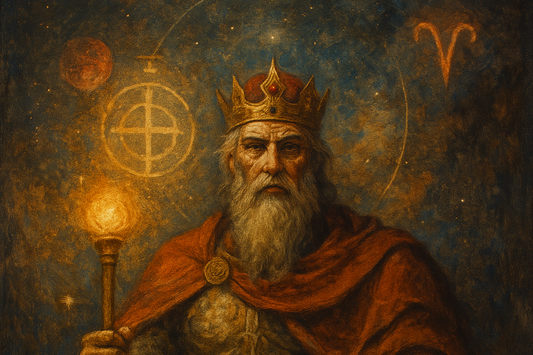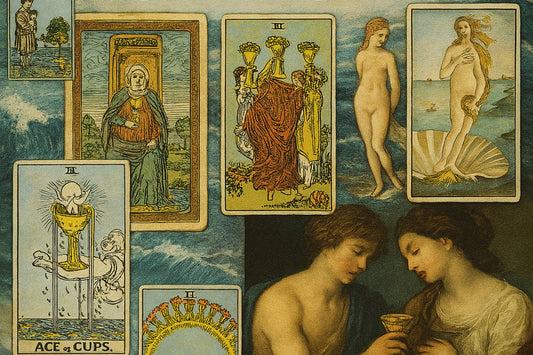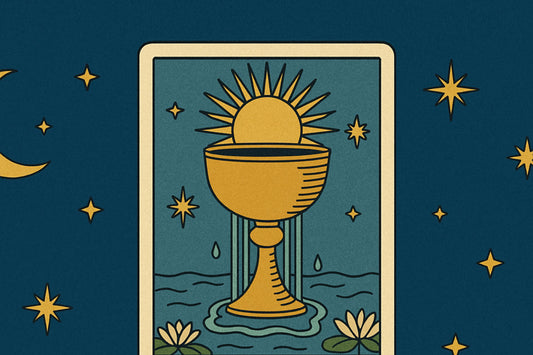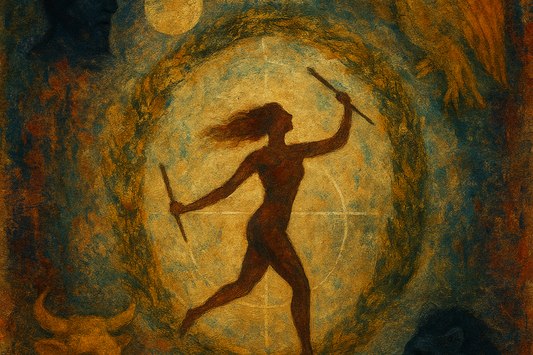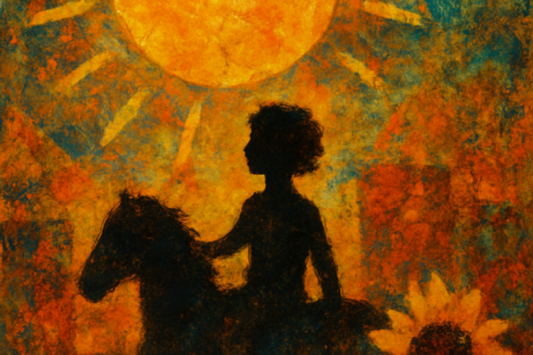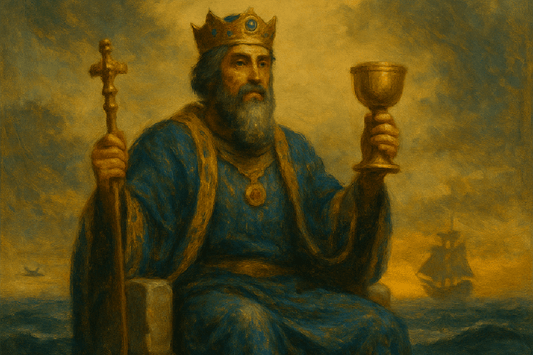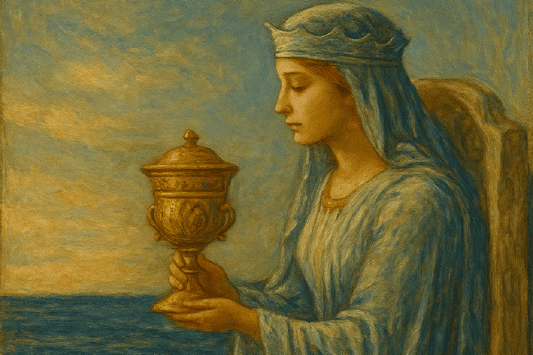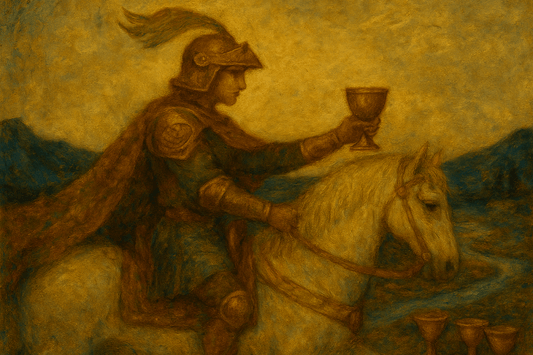The Empress in Tarot: Fertility, Creation and Archetypal Abundance
Tarot AccessoriesTable of Contents
- TL;DR: The Empress Quick Reference
- The Archetype of The Empress in the Tarot
- Symbolism and Imagery of The Empress
- Meaning of The Empress in a Tarot Reading
- Reversed Meaning of The Empress in a Tarot Reading
- The Evolution of The Empress Throughout History
- Numerology and the Number Three in Tarot
- Astrological Resonance of The Empress
- FAQs About The Empress in Tarot

TL;DR: The Empress Quick Reference
Upright: Fertility, creativity, divine feminine, nurturing, sensuality, abundance, embodiment, unconditional love, growth, beauty, nature, maternal archetype
Reversed: Smothering, stagnation, blocked creativity, emotional over-dependence, overindulgence, disconnection from the body, scarcity mindset, repressed femininity, creative blocks, conditional love
The Archetype of The Empress in the Tarot
The Empress is where spirit becomes flesh. She is the archetype of creation - not as an idea, but as a living, breathing form. She doesn’t speak in symbols or theories. She speaks in sensations: fullness, warmth, skin, soil, breath.
Where The High Priestess governs the inner world of knowing, The Empress governs the outer world of experience. She is the flowering after stillness - the womb after the void. In her, the divine becomes tangible. The seed becomes fruit.
She is not passive. She is generative. Her power is cyclical, rhythmic, and alive. When The Empress appears in a reading, something wants to be born - through you, with you, or from you. Your task is not to push. It is to allow.
This card reminds us that abundance is not a reward. It is a natural result of alignment with life’s fertile rhythms. The Empress doesn’t chase. She attracts.
Symbolism and Imagery of The Empress
In the Rider-Waite-Smith deck, The Empress sits on a plush throne amidst a wheat field and lush forest - a scene overflowing with the symbolism of fertility and life. Her robe is adorned with pomegranates, echoing both sensuality and mythological references to Persephone and the underworld. The cushion beneath her bears the symbol of Venus - the planet of beauty, pleasure, and attraction.
Behind her flows a river - the eternal feminine current, nourishing all it touches. Her crown, composed of twelve stars, links her to the zodiac, the seasons, and the archetypal cycles of nature and time. She is Earth-bound, yet cosmically attuned.
Unlike The High Priestess, who sits between pillars and behind a veil, The Empress is fully exposed - embodied, expressed, alive. Her realm is not mystery but manifestation. She represents the tactile, sensual dimension of the divine.
This is not an abstract goddess. This is life made lush. The Empress doesn’t invite you to decipher. She invites you to feel.
Related Cards to Explore
The Suit of Cups in Tarot: 14 Ways of Feeling
The Ace of Cups in Tarot: Emotional Awakening and Sacred Flow
Astrology of the Suit of Cups in Tarot: Planetary Meanings & Zodiac Correspondences
The Fool in Tarot: Sacred Trust, Archetypal Innocence and New Beginnings
The Magician in Tarot: Manifestation, Will and the Power to Begin
The High Priestess in Tarot: Inner Knowing, Mystery and Sacred Stillness
Meaning of The Empress in a Tarot Reading
When The Empress appears, she signals a time of growth, receptivity, and creation. This may manifest as literal fertility - pregnancy, birth, or new life. But more often, it speaks to the fertile ground of ideas, projects, relationships, and healing.
This card invites you to soften into trust. To nourish what’s beginning to emerge. To honour the body, the senses, the cycles - and to stop forcing outcomes. The Empress doesn’t operate through strategy. She magnetises through embodiment.
In relationships, she can reflect nurturing energy, sensual connection, or the presence of a loving mother figure. In creative work, she asks: what wants to come through you, rather than from you?
She reminds us that nature does not rush. Yet everything gets done.
Reversed Meaning of The Empress in a Tarot Reading
Reversed, The Empress may point to a disruption in your relationship with creation, embodiment, or care. You may be giving too much, over-nurturing, or losing yourself in others. Alternatively, you may be withholding - resisting growth, disconnected from your body, or afraid to receive.
This reversal often highlights creative block or emotional depletion. Something wants to flow, but it’s being stifled - by fear, control, or overextension. It can also signal a disconnection from the natural world, your sensuality, or your own inner rhythms.
In some contexts, the reversed Empress may show up as co-dependence, neediness, or using caretaking as a way to secure love. In others, she may represent a rejection of softness - a defensive refusal to allow vulnerability.
The invitation is simple but radical: come back into your body. Breathe. Feel. Receive.
The Evolution of The Empress Throughout History
The Empress is one of the most ancient and visually enduring figures in the tarot, yet her symbolism has evolved in quiet but profound ways. While she now represents abundance, creation, and the archetypal feminine, her early forms were far more political - even imperial.
Early Appearances – The Empress in the Visconti and Sforza Decks

In the earliest surviving tarot decks - which include the Visconti di Modrone tarot deck and the Visconti-Sforza tarot deck (15th century Italy) - The Empress appears enthroned and regal. She wears a crown, often three-tiered like the Holy Roman Empress, and holds a sceptre topped with an orb - symbols of worldly power, sovereignty, and divine rule.
There is no explicit Venusian energy in these early images. This Empress is not a mother or creator - she is a ruler. Her presence would have been immediately recognisable to Renaissance viewers as an image of temporal authority, reflecting The Empresses of the Holy Roman Empire or influential noblewomen of the time. The tarot, in these early iterations, often reflected hierarchical power structures rather than inner archetypes.
Marseille Deck – Transition Toward Archetype

In the Tarot de Marseille, The Empress retains her crown, sceptre, and throne - but subtle shifts begin to emerge. She becomes more serene, less militant. The orb becomes a shield bearing an eagle, a common imperial symbol, yet she now gazes outward with softened authority. Her presence begins to merge worldly and symbolic power - no longer just a ruler, but a mother of the realm.
These versions begin to hint at her later transformation: from empire to earth, from rule to resonance.
Christian Symbolism and the Number Three

In traditional numerology, Three is often associated with the Holy Trinity, and some tarot interpretations of The Empress placed her within a Christian framework. While the Pope (later Hierophant) and Papess (The High Priestess) held clerical symbolism, The Empress became a secular echo - a reflection of spiritual rulership turned earthly.
The connection between The Empress and Mary, the Mother of Christ, began to emerge during this time - infusing her with maternal, generative energy that would carry into the occult revival.
Occult Revival and the Influence of the Golden Dawn

In the 18th and 19th centuries, as tarot was reinterpreted through esoteric and mystical lenses, The Empress underwent her most significant shift.
The Hermetic Order of the Golden Dawn assigned her to the planet Venus, aligning her with beauty, fertility, and sensuality. She was associated with the Hebrew letter Daleth (ד), meaning “door” - symbolising a passage into life, form, and manifestation.
She also became linked to path 14 on the Tree of Life, between Chokmah (Wisdom) and Binah (Understanding), deepening her role as a mediator of archetypal creation.
No longer a crowned monarch, The Empress became the embodiment of sacred femininity - not just maternal, but magnetic, abundant, and fertile across all dimensions.
Rider-Waite-Smith (1909) – The Empress Fully Reimagined

The version we recognise today - illustrated by Pamela Colman Smith under the guidance of Arthur Edward Waite - is an overt departure from imperial imagery.
She is no longer a monarch of empire. She is the sovereign of nature.
Seated in a field of wheat, draped in pomegranate-covered robes, crowned with twelve stars and backed by a flowing river, she is Venus incarnate. Her sceptre no longer represents command - it channels natural power.
The eagle is gone. The crown remains, but now it marks her as cosmically attuned, not politically enthroned. She is the fertile earth, the creative body, the magnetic field of life itself.
This Empress is not of the court. She is of the cosmos.
Modern Decks and the Living Empress
Today, The Empress appears in a multitude of forms - as divine mother, Earth goddess, sensual muse, creative portal, gender-fluid birther, and regenerative force. Some decks lean into her softness, others her strength. Some return her to imperial robes, others depict her naked in a forest.
But at her core, she remains the same: the archetype of creation in motion.
The Empress is where idea becomes incarnation.
Where love becomes life.
Where the divine takes form - and calls it beautiful.
Numerology and the Number Three in Tarot
Three in tarot is the number of creation - the first movement beyond polarity. If One is will and Two is duality, then Three is synthesis. It’s what happens when tension gives birth to form.
The Empress embodies this fully. She doesn’t choose between opposites - she births something new from their union. She is the result of what has been seeded and felt. Three is expression. It is fruit on the vine.
In the Major Arcana, Three (The Empress) follows The High Priestess (2) - who holds inner knowledge - and brings that knowing into life, before becoming The Emperor (4). Where the Priestess listens, The Empress creates. Where the Priestess waits, The Empress nurtures.
Emotionally, the Three in tarot signals harmony and expansion. Energetically, it marks the pulse of life growing outward. The lesson of Three is simple: let what is gestating come into form. Don’t rush it - but don’t resist it either.
Astrological Resonance of The Empress
The Empress is ruled by Venus - the planet of beauty, love, pleasure, and attraction. Venus governs what we value, how we relate, and what makes life feel worth living. In The Empress, these energies are expressed in their most fertile, grounded form.
She embodies Earth-Venus, not air or fire - meaning her love is tactile, her pleasure is sensory, and her creation is physical. She isn’t abstract. She’s felt.
There’s also resonance between The Empress and Taurus, one of Venus’ ruling signs - a zodiac energy known for embodiment, nature, sensuality, and stability. Taurus knows how to receive. Taurus knows how to grow. And like The Empress, it knows the power of staying rooted while the world blooms around it.
This card teaches that attraction isn’t something you chase - it’s something you cultivate by becoming magnetic to what is truly aligned.
FAQs About The Empress in Tarot
What does The Empress mean in a love reading?
The Empress in a love reading often signals deep connection, nurturing energy, and emotional abundance. It may indicate a relationship rooted in care, sensuality, and growth - or the presence of a loving, stabilising force. In some cases, it can point to pregnancy or the birth of something new between two people.
Is The Empress a yes or no card?
The Empress is generally considered a “yes” card, especially in questions about growth, relationships, or creative potential. She signals positive outcomes through trust, receptivity, and alignment with natural cycles - not force or urgency.
What does The Empress mean when reversed?
Reversed, The Empress can reflect creative block, emotional burnout, or disconnection from your body or intuition. It may signal over-giving, co-dependence, or resistance to receiving support. The reversal invites you to restore balance by tending to your own inner landscape.
What element is The Empress associated with?
The Empress is associated with the element of Earth - grounding, nourishing, fertile and sustaining. While ruled by Venus (a planetary energy of love and beauty), her domain is the physical world: nature, the body, resources, and cycles of creation.
What archetype does The Empress represent?
The Empress represents the Mother, the Creator, and the Earth Goddess. She is the archetype of sacred embodiment - the one who gives form to feeling, who nurtures life into fullness, and who reminds us that pleasure and power are not opposites.


